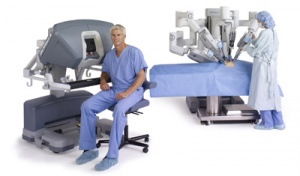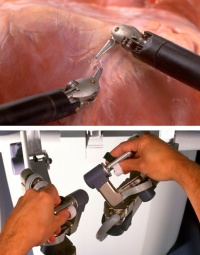Da Vinci Surgical System
Da Vinci Surgical System is a minimally invasive surgery performed with robotic assistance. The Da Vinci was created by Intuitive Surgical and is currently the only robotic surgical system approved by the Food and Drug Administration in 2000. The Da Vinci has been famed for its increased precision and enhanced range of motion in comparison to open surgery. Within the last 14 years, 1.75 million of these robotic procedures have been performed in the United States. [1]:
Contents
History
The first notion of robotic surgery was developed by National Aeronautics and Space Centre(NASA) in the 1980s.[2] Commercialization of these robotic surgical system began in the early 1990s, leading to the introduction of both Zues robotic system by Computer Motion and Da Vinci robotic system by Intuitive Surgical. Intuitive Surgical bought out Computer Motion in 2003 and now remains the only company to commercialize these robotic surgical systems. In 2000, the Da Vinci became the first system to be approved by the FDA and has flourished in the surgical field ever since.
System Overview
System Components
The system consists of two separate consoles the surgeon's console and the robotic console. The surgeon's console is where the surgeon sits and is provided with high quality 3D visual feedback. He or she is able to control the separate robotic console with the use of hand manipulators and foot pedals. The movements of the surgeons hands are translated into the computer which then moves these wrist instruments. This movement is scaled up by ten folds allowing for increased precision. Precision is also enhanced by the systems ability to correct for tremors in hand movements.[3] The separate robotic console consists of three to four robotic arms. One arm holds a laparoscopic camera that provides the visual feedback to the surgeon console. Attached to two robotics arms are the EndoWrist instruments which provide 7 df similar to the human hand. This increased range of motion compared to traditional laparoscopic surgeries allows for greater maneuverability. [2]
Training
The Da Vinci system requires extensive training because the system provides no form of haptic feedback, every instinct is learned through visual perception. Intuitive Surgical teams up with each hospital to run surgeons through four phases of training:[4]
- Phase 1: Introduction to da Vinci (Product Training)
- Phase 2: da Vinci Technology Training (Product Training)
- Phase 3: Initial Case Series Plan(Skills Application)
- Phase 4: COntinuing Development (Skills Application)
Each hospital varies in how each candidate is given credentials or privileges.
Procedures
Types of surgeries that have been approved by the FDA and can be completed with the Da Vinci[5]
- Cardiac Surgery
- Colorectal Surgery
- General Surgery
- Gynecologic Surgery
- Head & Neck Surgery
- Thoracic Surgery
- Urologic Surgery
Patient Advantages
The Da Vinci surgical system creates many benefits for patients. The increased precision of the surgeon allows for less trauma to the patient's body. Benefits of the Da Vinci as compared to open surgery include shorter hospital stays, less pain, less blood loss, and less scaring.[3]
Patient Risks
Normal risks of surgical procedures are associated with the Da Vinci, however the system also contains various other patient risks. Research has shown there is a number of technical difficulties and complications that are still occurring during these robotic procedures. Over a 14 year period the number of injuries and death events per procedure stayed around 83.4 for every 100,000 procedures performed. [1] Device and instrument malfunctions composed a majority of these reports. The few of the most common device malfunctions were parts falling off into patients, electric arcing of instruments and unintended movement while operating.[6] Aside from technical difficulties there has also been several lawsuits filed associated with patient injury due to lack of training on the systems. [7]
Costs
The average unit cost per machine is $1 to $2.5 million. On a procedural basis, the da Vinci surgery is an additional $1,600 than the general procedure without robotic assistance, this is about a 6% increase. [8]: Most insurance companies do not reimburse at higher rates for these robotic assisted procedures then they would for the general procedure.
References
- ↑ 1.0 1.1 Alemzadeh, Homa et al. “Adverse Events in Robotic Surgery: A Retrospective Study of 14 Years of FDA Data.” Ed. Hyun-Sung Lee. PLoS ONE 11.4 (2016): e0151470. PMC. Web. 20 Feb. 2017.
- ↑ 2.0 2.1 Schreuder, H. and Verheijen, R. (2009), Robotic surgery. BJOG: An International Journal of Obstetrics & Gynaecology, 116: 198–213. doi:10.1111/j.1471-0528.2008.02038.x
- ↑ 3.0 3.1 Robotic Surgery. Mount Carmel Health System, n.d. Web.
- ↑ "Da Vinci® Training." Intuitive Surgical - Training. N.p., n.d. Web. 19 Feb. 2017.
- ↑ "The Da Vinci® Surgical System." Da Vinci Surgery - Minimally Invasive Robotic Surgery with the Da Vinci Surgical System. N.p., n.d. Web.
- ↑ Kirkpatrick, Tara, MD. "Robotic Surgery: Risks vs. Rewards." Robotic Surgery: Risks vs. Rewards | AHRQ Patient Safety Network. N.p., n.d. Web. 20 Feb. 2017
- ↑ Written by Cameron Scott | Published on August 10, 2016. "Is Da Vinci Robotic Surgery a Revolution or a Rip-off?" Healthline. N.p., 10 Aug. 2016. Web. 20 Feb. 2017.
- ↑ Barbash, Gabriel I., M.D., and Sherry A. Glied, PhD. "New Technology and Health Care Costs - The Case of Robot-Assisted Surgery — NEJM." New England Journal of Medicine. The New England Journal of Medicine, n.d. Web.

